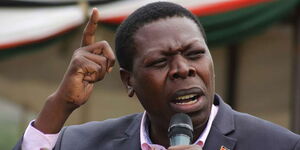Early in the week, the internet was awash with pictures of graffiti plastered on the Nairobi Expressway, which is still under construction.
The graffiti, bearing one of the most conspicuous names in the art industry, caused a division among social media users with one group supporting the move to plaster it on President Uhuru Kenyatta's flagship project, while a second group vehemently opposed it, terming the drawing as careless and degrading to the project.
Flossin Mauwano is a household name. The artist behind this sobriquet is one Stephen Mule.
When Kenyans sustained their sharp criticism of him for the graffiti, he saw it wise to publicly address the drawing inscribed on top of one of the pillars of the Ksh65 billion Expressway and that has since gone viral.
Speaking to a local publication on Friday, March 18, Flossin Mauwano distanced himself from the graffiti, expressing shock and dismay on how the person behind the inscription scaled the high pillars unnoticed.
Defending himself, the street artist added that Flossin Mauwano is no longer a person but a movement comprising fans and supporters. In his defence, he argued that anyone can plaster the graffiti on any surface without his knowledge.
"People have been asking how I got all the way up, but to be honest, Flossin Mauwano is a movement and one of my fans probably did it. Just to be clear, I am not the one who wrote the graffiti. Actually, I am in awe of how the ardent fan got the signature up there…it’s a puzzle," he stated.
"It is my pride that I came up with something that the community has embraced and it is a big honour."
Revealing the reason behind plastering roads and buildings with his signature mark, the artist noted his intention was to create awareness to road users.
Throughout the week, his graffiti attracted a lot of reaction with some Kenyans describing the act as outright vandalism which is punishable by law.
To address the high cases of vandalism, the Kenya National Highway Authority (KeNHA) introduced a raft of measures to deal with individuals defacing government projects.
"Those found defacing road infrastructure risk being fined Ksh85,000, and this includes those printing graffiti," one of the measures introduced by KeNHA states.
In 2013, the authority tabled a Bill in Parliament seeking to fine individuals defacing infrastructure up to Ksh1 million. However, some activists have defended the artists stating that it is a form of expression.
What Pushed Flossin Mauwano into Street Grafitti
In a previous interview, Flossin Mauwano revealed that a tragic event pushed him into street graffiti, gaining prominence in the city.
His parents were knocked down along the busy Lang'ata Road when he was a kid. Witnessing the incident traumatised him and later birth his love for inscribing roads and buildings with his trademark graffiti to create awareness.
"In 1997, I watched my parents get knocked down on the highway while escaping an irate crowd following election chaos that erupted that year. The vivid picture of their lifeless bodies has forever been embedded in my head.
"My major goal is to warn drivers to do what they are supposed to do after seeing the tagline. Most drivers feel puzzled when they see that notice. They may not understand it, but they may believe there is a gang around that could strike at any minute, but overall, they become wary of their surroundings," he stated.












